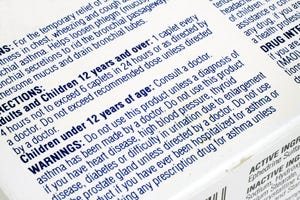March 11, 2015
|
Recent Federal Drug Administration (FDA) regulation changes for the pharmaceutical industry are forcing many firms to adjust their processes (see sidebar). The largest pharmaceutical packager in the business—Catalent Pharma Solutions—is no exception. Catalent's proprietary designs include the RxBarrier+™ Plus for oral solid medications, DelPouch® unit-dose delivery system for lotions, creams and ointments and the DelStrip® unit-dose delivery system for thin film strips.
“The impact of the new FDA regulation means that the packaging inserts will now be larger and more complex to accommodate the addition of various features and the increase in font size of the text,” says Maria Serra, quality assurance manager for Catalent's Puerto Rico facility. “Reading a sheet of that size will consequently take more time and larger equipment to accommodate the larger insert sizes,” she says. “Our goal is to reduce the time it takes for verifications in order to increase efficiencies for both our customers and ourselves.”
Big changes are now unfolding at the 82,000-sq-ft plant, which employs 160 and produces more than 5 million inserts and 80 million labels each year in various languages. The company is switching presses, installing folders to increase capacity around large-formats, adding ergonomic pieces to its cutters for handling heavier bundles and adopting computer-to-plate processing. Another significant adjustment is Catalent's recent installation of Digital-Page, proofreading software from Global Vision (www.globalvisioninc.com).
“We have been working with Global Vision for more than 10 years,” says Serra. “We already have the Scan-TVS, the scanner-based artwork comparator system, and we really wanted to incorporate Digital-Page so that not only our production department can benefit from this technology, but also our prepress department. It would enable us to shift from a manual proofreading process to an automated process, allowing for quicker verifications, better error detection and a happier QC staff.”
“With many changing regulations and the need to achieve complete content integrity, it is becoming increasingly important for those in the pharmaceutical industry to be able to ensure complete accuracy on all packaging components,” says Global Vision president Reuben Malz. “Our solutions are designed to eliminate the risk of errors and give peace of mind during the content-verification process.”
Catalent uses Scan-TVS on the production floor to verify from the customer proof to the first sample copy off the press. Digital-Page, which works between electronic files, was incorporated into the prepress workflow, giving Catalent a chance to catch any errors that may have occurred prior to the actual printing.”
A fool-proof workflow
|
The FDA’s regulation changes are intended to make increasingly complex drug labels more readable. |
The system—which meets FDA 21 CFR Part 11 and EMEA requirements—automatically overlays two files and compares them on a pixel-to-pixel basis to uncover any discrepancies. At Catalent, artwork for the inserts and labels arrive as PDFs. The first step for the prepress department is to make a copy—either in PDF or EPS format—that will be the working file up to the sample press run. Here, Digital-Page performs its first check, comparing text, fonts, graphs, images, missing or added elements as well as color and registration errors in the customer's original file and Catalent's copy.
If no discrepancies are found, prepress develops the copy into proofs and step-and-repeat layouts. Before printing a sample label or insert, the files are verified again against the original. The final check happens with Scan-TVS at the production level. Here Scan-TVS is used to scan the printed sample and compare it to the customer's file to ensure that the content remains unchanged.
“What we are doing with Digital-Page is supporting the efforts of our customers to have a proof-less process,” says Serra. The “proof-less” goal is to have a workflow with enough reliability that a customer will let Catalent's prepress and quality-assurance departments give the final go-ahead before starting the full press run.
“We can save our customers time because we currently cannot go to press until we receive approval from them,” says Serra. “Using a proof-less process, we could approve a proof within hours instead of days as it eliminates the need for our customers to physically come to our facility to review and approve it.”
One target for Catalent is product launches, which it says it already performs more than any firm in the industry. “If the customer wants to launch a new product, they have time constraints because they want to have that product in the market as soon as possible,” says Serra. Turnaround time is typically 24 to 48 hr, but going “proof-less” would shift launches into a higher gear. All that remains for Catalent is to bring its clients onboard.
“We do have a big customer—Pfizer—that has come to the facility,” says Serra. “If they approve our test, they will certify us as a proof-less supplier and allow us to make revisions without hard-copy proofs. Pfizer is the first to do this, but once you have one customer, others will come and see.”
The early results from Digital-Page are promising and have Catalent eyeing further investment. “One of the other facilities will probably be joining us in the same effort and, internally, prepress is so happy that they are willing to install another Digital-Page system,” says Serra. “The product supervisor would like another at once.”
More information is available: |
Global Vision, 800/501-0511. www.globalvisioninc.com . |
About the Author(s)
You May Also Like




